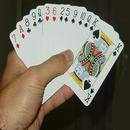Subject: Richard III 'found'.
Posted by: romeomikegolf
Date: Sep 12 12
Archaeologists think they may have solved a 500 year old mystery by uncovering the remains of Richard III.
 http://www.bbc.co.uk/news/uk-england-leicestershire-19561018
http://www.bbc.co.uk/news/uk-england-leicestershire-19561018
Posted by: romeomikegolf
Date: Sep 12 12
Archaeologists think they may have solved a 500 year old mystery by uncovering the remains of Richard III.
61 replies. On page 2 of 4 pages. 1 2 3 4
daver852 


|
I read the story about the announcement with great interest. However, a lot of people (including myself) remain unconvinced. It would be more accurate to say that the DNA analysis shows that the bones "could" belong to Richard III. http://www.newscientist.com/blogs/shortsharpscience/2013/02/leicester-body-richard-iii.html Reply #21. Feb 04 13, 10:51 AM |
C30


|
I don't think DNA is EVER 100% positive, is it? The best they can say is that there is a strong probability ? So "as far as can be ascertained", DNA matches, and "in all probability" positive. Reply #22. Feb 04 13, 11:37 AM |
daver852 


|
Well, the problem in this case is that all they could apparently recover was mitochondrial DNA. They compared this to two matrilinear descendents of Richard's sister. Because we are going back 20 or 25 generations, if the haploid group is a common one, there is a good chance of a random match. Here's an article with a more detailed explanation: http://www.guardian.co.uk/uk/2013/feb/04/richard-iii-skeleton-bone-dna So while the DNA match is evidence that the skeleton may be Richard III, it is not definitive proof. They will probably do a facial reconstruction, and compare it to contemporary portraits - this is one of the techniques used to identify the head of the French King Henri IV. It will be interesting to read the full report as more information becomes available. Reply #23. Feb 04 13, 1:08 PM |
slytherinwitch 


|
They did a facial reconstruction from the skeleton and the team had seen the results prior to the press conference. Here are some shots of the results. http://sphotos-f.ak.fbcdn.net/hphotos-ak-ash3/600743_10200661887369110_149414310_n.jpg http://sphotos-g.ak.fbcdn.net/hphotos-ak-prn1/544383_10200661885289058_1571844917_n.jpg Reply #24. Feb 04 13, 4:56 PM |
eyhung 


|
Although I believe it's highly likely to be Richard III, given the location, the wounds, the spine, _and_ the DNA on top, the facial reconstruction indicates to me that they were probably basing it off the famous portrait. Reply #25. Feb 05 13, 2:39 AM |
flopsymopsy 


|
The forensic anthropology laboratory at the University of Dundee is well-known and the work they do on historical and current, often criminal, cases is of international renown. They do a lot of work in, for example, identifying the victims of disasters and I do not believe that Professor Wilkinson (who did the reconstruction) would be a party to any sort of deception or analysis based on a preconceived idea, she has far too much to lose. Reply #26. Feb 05 13, 8:25 AM |
daver852 


|
I don't believe that any of the scientists involved in this project would deliberately falsify any of the results or findings. But it is important to remember that they WANT these bones to belong to Richard III, and that unless Richard III had a relatively rare strain of mitochondrial DNA, the DNA match really doesn't really prove much. It is still a problem for me that these bones were not found in a coffin; from sources I've read online, it doesn't appear that it was even wrapped in a shroud. This would have been very unusual for a royal burial, even one involving a defeated king. Richard was, after all, Henry VII's cousin, and we know for a fact that shortly after Richard's death, Henry (a notorious tightwad) authorized a payment of ten pounds to erect a memorial to Richard: http://www.leicesterchronicler.com/richard.htm Since there were hundreds or even thousands of men killed at the Battle of Bosworth Field, and other battles in the Wars of the Roses, I think it is very difficult to "prove" that this skeleton belonged to Richard III. As I said before, it will be interesting to see the final report when it issued. All we have to go on now are newspaper articles which are, by their very nature, somewhat sensationalized. Reply #27. Feb 07 13, 6:47 PM |
lesley153

|
I thought facial reconstructions were done with pegs and standard/average tissue thicknesses. If there's a portrait, and the reconstruction resembles it, that's a bonus. Reply #28. Feb 07 13, 7:05 PM |
flopsymopsy 


|
The software devised at Dundee is quite sophisticated and as Leslie says, uses a system of pegs set at intervals around the skull which provide fixed points for the addition of muscles and soft tissues. It's a standardised technique and is used for all the facial reconstruction work. What was striking on the Channel 4 programme about the discovery was how the Tudors altered Richard's image. There was a portrait done from memory after his death but subsequent images gradually included distortions - his shoulder was hunched more, his hand was clawed and thinned down as though one arm was withered, and the two well-known images and the legend of his deformity obviously meet up with the Tudor whispering campaign against him. So it isn't that the reconstruction looks like the portraits, it's more that he probably looked like the model but the portraits were altered. It's true the DNA isn't 100% but that's not possible. What is also true however is that the balance of probability is strongly on the side of this skeleton being Richard. They did know roughly where he might be buried, apart from the Tudor rumour about his body going into the river, and that turns out to be where he was. There probably was a thin shroud but the soil in this area and up to Leicester is quite acidic so no surprise that there's no material left. The skeleton didn't have a hunchback but teenage-onset scoliosis, a sideways curvature that would not have stopped him wearing armour (which would have been tailored for him anyway) but which altered the angle of his head somewhat, maybe giving the appearance of a raised shoulder. He had battle wounds and wounds post mortem. It is all those things put together which make it probable, as the academics said, that this is Richard III beyond all reasonable doubt. Reply #29. Feb 07 13, 7:40 PM |
jabb5076 


|
To add to what Flopsy so eloquently stated is an additional point indicating the skeleton is that of Richard lll--skeletal analysis shows that the person ate a diet very rich in meat and fish, food only the wealthiest could regularly consume. And although it's certainly true that hundreds or more soldiers died during that time frame, it is highly unlikely that some random soldier would have had the means to eat a diet like that of the wealthiest nobility. Reply #30. Feb 07 13, 8:01 PM |
daver852 


|
Well, I think you're just not considering all the possibilities. There were were probably hundreds of knights and yoemen killed at Bosworth, and while I'm not familiar with the history of Leicester, I'm sure there were other battles nearby during the hundred year window indicated by the Carbon-14 dating of the bones that would have shown the same dietary profile. You didn't need to be a king to enjoy a good diet, just fairly well off. I'm not saying that the bones don't belong to Richard, I'm just saying that I haven't seen anything yet that remotely approaches "proof" that they do. Reply #31. Feb 07 13, 8:57 PM |
C30


|
On the plus side - the results did not prove that it wasn't the King either! Reply #32. Feb 08 13, 1:19 AM |
daver852 


|
Here's an interesting point: why didn't they compare the skeleton's DNA with existing relics of Edward IV? His tomb was opened in 1789, and many "relics" removed, many of which still exist: http://makinghistory.sal.org.uk/ajax.php?id=27&st=2_a_3&p=0 Reply #33. Feb 08 13, 2:19 AM |
supersal1 

|
I couldn't get that one to open properly. The direct link mentioned a lock of hair and I understand that for DNA testing on hair, the bulb/root is needed as well. A sample of fluid from the coffin may or may not show anything after all this time. On another note, does anyone think the reconstruction looks like Quentin Tarantino? Reply #34. Feb 08 13, 9:01 AM |
daver852 


|
I do not know who Bendor Grosvenor is, but he must be a brilliant man, since he thinks very much like me :) A very interesting article about the Richard III case. I did not know that the purported grave of Richard III was the the first and only site that the team had excavated. http://www.arthistorynews.com/articles/1970_Richard_III Reply #35. Feb 08 13, 1:39 PM |
trojan11

|
Doubt still persists, I fear. "Richard III was said to be physically deformed; the physical deformity symbolizing his moral depravity." A.J Pollard. There is no contemporary description to back up such suggestions of physical deformity. Dominic Mancini, who saw Richard III, makes no mention of any such thing and seems to have regarded him as being physically unexceptional. Mancini was certainly no fan of Richard III, so it seems likely, to me, that he would have grasped upon any outstanding defect of the late king. Nicholas von Papen, visiting in 1484, says in his journal that the king was three fingers taller than him, leaner and and more delicately built. He makes no mention of any kind of deformity. Surely one of these two educated and well travelled men would have made mention of any kind of grotesque deformity? Reply #36. Feb 08 13, 2:39 PM |
daver852 


|
You make a good point. Most of the descriptions of Richard having some kind of physical deformity were made long after his death. We also know that Richard was a famous warrior, and very powerful in battle. I am no physiologist, but the photos I have seen of the skeleton show a very severe spinal deformity. Could Richard have killed Henry VII's standard bearer, and unhorsed Sir John Cheyne (whose skeleton shows he was 6'8"), if he had suffered from such an advanced case of scoliosis? All we have heard thus far are arguments about why the skeleton must be Richard's, and little, if any, publicity has been given to those who harbor doubts. Again, the skeleton could be Richard III, but I have yet to see any definitive proof. I hope there will be a final report that explains the findings in more detail. Reply #37. Feb 08 13, 4:25 PM |
daver852 


|
Another interesting article about the identification of Richard III's remains. From what I've read in various articles, the mitochondrial DNA found in in the Leicester skeleton and matrilineal descendents of Richard's sister are a close, but not exact match. Also, the mitochondrial group found in the skeleton is shared by about 1.3% of the general population of England. Which is kind of like saying, "This person's mother's maiden name was Smith, and the skeleton's mother's maiden name was Smith." Not really exclusive enough to rule out coincidence. http://www.ancestryreport.com/is-richard-iii-the-parking-lot-king-not-so-fast/ Reply #38. Mar 24 13, 12:14 PM |
romeomikegolf


|
The latest article about his tomb. http://www.bbc.co.uk/news/uk-england-23355604 Reply #39. Jul 18 13, 4:43 AM |
romeomikegolf


|
An update on the tomb. http://www.bbc.co.uk/news/uk-england-leicestershire-24159531 Reply #40. Sep 19 13, 1:16 PM |
61 replies. On page 2 of 4 pages. 1 2 3 4
Legal / Conditions of Use
|
|
 :
: